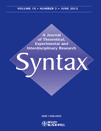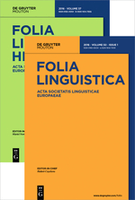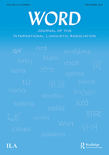
Acta Linguistica Academica
Scope & Guideline
Advancing Knowledge in Linguistics and Literary Theory
Introduction
Aims and Scopes
- Syntactic and Morphological Analysis:
The journal frequently explores the structures and rules governing syntax and morphology, often through case studies in Hungarian and comparative analyses with other languages. - Pragmatics and Sociolinguistics:
Research in this area examines the use of language in social contexts, including studies on small talk, phatic interaction, and sociopragmatic features across different cultures. - Language Acquisition and Processing:
Papers often investigate how language is acquired and processed, with a focus on bilingualism and the cognitive aspects of language learning. - Cross-linguistic Perspectives:
The journal promotes studies that draw comparisons between languages, shedding light on universal grammar and language-specific phenomena. - Historical and Diachronic Linguistics:
Contributions often include historical analyses of language change over time, particularly in the context of Hungarian, providing insights into the evolution of linguistic structures.
Trending and Emerging
- Neural Linguistics and Machine Learning:
There is an increasing focus on the application of neural networks and machine learning techniques to linguistic problems, particularly in areas such as machine translation and language modeling. - Cross-Cultural Pragmatics:
Emerging studies are exploring how language usage varies across cultures, with a specific emphasis on small talk and phatic communication, reflecting a growing interest in sociolinguistic dynamics. - Dynamic and Contextual Language Theories:
Research is moving towards theories that account for language as a dynamic and context-dependent phenomenon, including discussions around representationalism and contextual semantics. - Language and Technology Interactions:
Papers are increasingly addressing the intersections between language and technology, particularly in the context of language processing and computational linguistics. - Morphosyntactic Variation and Change:
A trend towards understanding morphosyntactic variation and its implications for language theory is emerging, particularly in the context of Hungarian and other Uralic languages.
Declining or Waning
- Phonological Studies:
Research specifically focusing on phonological aspects, such as sound change and phonetic analysis, has decreased in frequency, possibly due to a shift towards more syntax and morphology-centered studies. - Traditional Language Teaching Methods:
There is a noticeable decline in papers discussing conventional language teaching methodologies, reflecting a broader trend towards innovative and technology-integrated approaches in language education. - Comparative Syntax of Lesser-known Languages:
While comparative studies are still present, there seems to be a waning interest in exploring the syntax of lesser-studied languages in favor of more established languages such as English and Hungarian.
Similar Journals

Journal of Slavic Linguistics
Navigating the Complexities of Slavic Linguistic StructuresJournal of Slavic Linguistics, published by SLAVICA PUBLISHERS, is a key academic resource dedicated to the exploration of Slavic languages and linguistics. Established to provide a comprehensive platform for scholarly research, this journal addresses the intricate dynamics of Slavic phonetics, syntax, semantics, and discourse, making significant contributions to both theoretical and applied linguistics. The journal holds an impact factor that reflects its value in the linguistic community, particularly as it is ranked in the Q4 category in Linguistics and Language for 2023. With a focus on a wide range of topics within the field, the Journal of Slavic Linguistics serves as an essential reference for researchers, educators, and students alike, fostering an appreciation and deeper understanding of Slavic linguistic phenomena. Although currently not an Open Access journal, it remains accessible to a broad audience keen on engaging with contemporary linguistic scholarship.

Languages
Fostering collaboration in the vibrant world of linguistics.Languages, published by MDPI, is a prestigious open-access journal dedicated to the field of Linguistics and Language studies. Since its inception in 2016, this journal has rapidly established itself as a leading platform for high-quality research, achieving an impressive Q1 ranking in 2023 and standing out in both the Arts and Humanities as well as the Social Sciences categories with significant percentile rankings (76th and 74th respectively). Based in Switzerland, Languages fosters an international community of scholars who are committed to exploring the multifaceted dimensions of language, from theoretical frameworks to practical applications. With a robust e-ISSN of 2226-471X, the journal prioritizes accessibility, allowing researchers, professionals, and students to freely engage with cutting-edge research and insights. By bridging the gap between theory and practice, Languages plays a crucial role in advancing our understanding of linguistic phenomena, making it an invaluable resource for anyone invested in the study of language.

Turkic Languages
Advancing Knowledge of Turkic Language DynamicsTurkic Languages is an esteemed academic journal published by HARRASSOWITZ VERLAG, dedicated to the exploration and analysis of Turkic languages within the broader fields of linguistics and language studies. With an ISSN of 1431-4983, this journal serves as a vital platform for researchers, professionals, and students interested in the intricate structures, dynamics, and cultural contexts of Turkic languages. Although it currently operates without an Open Access option, the journal's commitment to quality research is evident in its placement within the Q4 category of Linguistics and Language for 2023, alongside its Scopus rankings where it stands in the 30th and 26th percentiles for Language and Linguistics across Arts and Humanities and Social Sciences, respectively. The journal's scope encompasses a variety of linguistic phenomena, striving to foster a deeper understanding of Turkic languages and their significance in the global linguistic landscape. With converged years from 2017 to 2022, Turkic Languages continues to uphold its reputation as a crucial resource for advancing scholarship in this specialized field.

BRAIN AND LANGUAGE
Pioneering Research on Language Mechanisms and CognitionBRAIN AND LANGUAGE is a premier journal published by Academic Press Inc Elsevier Science, dedicated to fostering scholarly communication in the fields of Cognitive Neuroscience, Linguistics, Psychology, and Speech and Hearing. With its ISSN 0093-934X (Print) and 1090-2155 (Online), the journal has established a significant presence since its inception in 1974, continuing to provide valuable insights into the intricate relationship between brain function and language processing. This journal is highly regarded, boasting a 2023 ranking of Q1 in Linguistics and Language, reflecting its influential contributions to the field, alongside Q2 rankings in categories such as Cognitive Neuroscience and Experimental Psychology. With a rigorous peer-review process, it serves as an essential resource for researchers and professionals seeking to deepen their understanding of language mechanisms and their cognitive underpinnings. Despite not being an Open Access journal, BRAIN AND LANGUAGE ensures that its articles are widely accessible and of high quality, making it an indispensable platform for both emerging and established scholars aiming to expand the boundaries of research in language and cognition.

Journal of Greek Linguistics
Exploring the Depths of Greek Language and CultureThe Journal of Greek Linguistics, published by BRILL, is a premier platform dedicated to advancing the study of Greek language and its historical and contemporary implications within the broader field of linguistics. With an impact factor recognized in the linguistics community, this journal significantly contributes to the academic discourse surrounding Greek linguistics and its relevance in cultural and social studies. First made open access in 2016, it is now accessible to a global audience, facilitating a collaborative environment for researchers, scholars, professionals, and students alike. The journal is proudly positioned in the Q2 quartile for linguistics and language, reflecting its esteemed standing in the academic community, and it ranks within the top 30% in both the Arts and Humanities and Social Sciences categories according to Scopus. With a focus on the intersection of language, culture, and society, the journal invites contributions that offer new insights and promote interdisciplinary research. The Journal of Greek Linguistics continues to be an essential resource for those engaged in the rich and evolving conversation about the Greek language.

Syntax-A Journal of Theoretical Experimental and Interdisciplinary Research
Pioneering Research at the Intersection of Theory and ExperimentationSyntax - A Journal of Theoretical Experimental and Interdisciplinary Research is a premier journal dedicated to advancing the field of linguistics, serving as a platform for high-quality research that spans theoretical, experimental, and interdisciplinary dimensions. Published by Wiley and located in the United Kingdom, this journal holds a prestigious Q1 ranking in the Linguistics and Language category as of 2023, highlighting its significance and impact within the academic community. With an impressive Scopus ranking of Rank #204/1088 in Arts and Humanities and Rank #239/1167 in Social Sciences, the journal occupies an influential position among leading publications, appealing to researchers, professionals, and students alike. Syntax encourages innovative studies that contribute to our understanding of language structure and use, making it an essential read for anyone invested in linguistic research. Although the journal is not Open Access, its commitment to rigorous scholarship ensures that it remains a vital resource for those exploring cutting-edge theories and empirical findings in the dynamic field of linguistics.

Zeitschrift fur Sprachwissenschaft
Exploring the nuances of language and communication.Zeitschrift für Sprachwissenschaft, published by DE GRUYTER MOUTON, is a leading journal in the field of linguistics that has been contributing to scholarly discourse since its inception in 1982. With an ISSN of 0721-9067 and an E-ISSN of 1613-3706, the journal offers an Open Access model since 2017, ensuring widespread dissemination of research findings. Positioned in Q2 of the Linguistics and Language category for 2023, it ranks #312 out of 1088 in the Arts and Humanities and #370 out of 1167 in Social Sciences, reflecting its robust impact and contribution to the field. This German-based journal covers a diverse range of topics related to language and linguistics, appealing to researchers, professionals, and students alike. By fostering interdisciplinary dialogue and showcasing innovative research, Zeitschrift für Sprachwissenschaft plays a critical role in advancing our understanding of language in various contexts. The journal is located at Genthiner Strasse 13, 10785 Berlin, Germany, inviting scholars globally to contribute to its mission of enhancing linguistics research.

FOLIA LINGUISTICA
Advancing Linguistic Knowledge Since 1967FOLIA LINGUISTICA, published by WALTER DE GRUYTER GMBH, is a premier scholarly journal dedicated to the field of linguistics. Established in 1967, the journal has consistently provided a platform for innovative research and scholarly discourse in language and linguistics, contributing significantly to the academic community's understanding of language structures, usage, and cognitive processes. With its classification in the top quartile (Q1) of linguistics and language in 2023, FOLIA LINGUISTICA holds a respectable rank (#282/1088) within the Arts and Humanities category and an admirable percentile rank of 74th, ensuring its position at the forefront of linguistic scholarship. Researchers and academics from around the globe can access a wealth of knowledge and cutting-edge research findings through this esteemed publication, which is vital for anyone looking to engage with the latest advancements in linguistics. Located in Berlin, Germany, FOLIA LINGUISTICA encompasses all aspects of language research, making it an indispensable resource for researchers, professionals, and students alike seeking to deepen their understanding of language and its complexities.

Poznan Studies in Contemporary Linguistics
Navigating the complexities of contemporary language.Poznan Studies in Contemporary Linguistics, published by DE GRUYTER MOUTON, is a pivotal journal in the field of linguistics, with an ISSN of 0137-2459 and an E-ISSN of 1897-7499. Located in Germany, this esteemed journal has consistently contributed to the academic landscape since its inception. As of 2023, it holds a Q2 category rank in Linguistics and Language and boasts commendable Scopus rankings, featuring in the 69th percentile for Arts and Humanities and the 66th percentile for Social Sciences. The journal emerges as a vital platform for scholars to explore contemporary linguistic theories and practices, making it an essential resource for researchers, professionals, and students alike. With a converged publication period from 2007 to 2024, it aims to facilitate a deeper understanding of linguistic advancements and trends. While the journal currently does not offer open access, its rigorous peer-review process ensures the highest quality of published research, strengthening its role as a leading discourse in the dynamic field of linguistics.

WORD-JOURNAL OF THE INTERNATIONAL LINGUISTIC ASSOCIATION
Elevating discourse through rigorous research and analysis.WORD-JOURNAL OF THE INTERNATIONAL LINGUISTIC ASSOCIATION is a leading peer-reviewed journal dedicated to advancing the field of linguistics and language studies. Published by Routledge Journals, Taylor & Francis Ltd, this esteemed journal has earned a reputation for its rigorous scholarship, reflected in its 2023 Q2 ranking in Linguistics and Language and its solid performance in Scopus Ranks. Encompassing a wide range of topics—from theoretical frameworks to empirical research—WORD serves as an essential resource for linguistics researchers, educators, and students alike. While currently not operating under an open access model, the journal is committed to providing high-quality, impactful research articles that contribute significantly to the linguistic community. With its convergence periods from 1998 to 2009 and 2015 to 2024, WORD continuously fosters the discourse of language studies, ensuring that critical insights and discussions are accessible for ongoing academic exploration.